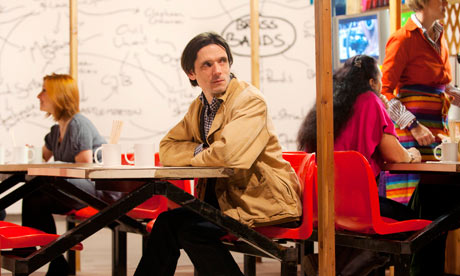Jeremy Deller has been chosen to represent Britain at this year's 55th Venice Biennale
"..a pied piper of popular culture"
Andrea Rose, British Council's Pavillion Commissioner


Folk ArchiveBegun in 2000, the ‘Folk Archive’ is an ongoing project by artists Jeremy Deller and Alan Kane that is about what we might gain from vernacular art – amateur visual culture that’s unbounded by theory or by the teleological tug of future art history. Focused on Britain and Northern Ireland, the archive has none of the campy amour propre of, say, Jim Shaw’s collection of ‘Thrift Store Paintings’ (1970–2005). Rather, its contents are things that are truly valued, truly loved.
But what peculiar objects of affection. At the entrance of the archive’s recent Barbican outing stood a Michael Jackson Scarecrow (2005), a plush toy monkey perched on its shoulder and a vindicated grin on its lips. (I was reminded of a recent headline on the satirical news site The Onion: ‘Enchanted by Own Innocence, Michael Jackson Molests Self’.) This is one of a number of works in the show that were informed by Pop culture, and that saved it from being a compendium of archaic practices – barrel-rolling, gurning, mummers’ plays – that have survived into the present day. ‘Folk’, here, has gone electric, like Bob Dylan at the 1965 Newport Festival, and with similarly divisive results. Witness two near-identical Photoshop-ed images, in which the ‘South Park’ (1997–2005) kids are pictured as supporters of the Glasgow football clubs Rangers and Celtic, summing up years of Protestant versus Catholic sectarianism in a single Pop reference (imagine cries of ‘Cartman, you’re mom’s a crack whore’ being belted from the terraces of Ibrox Stadium).
Sometimes the works in the ‘Folk Archive’ look a lot like ‘proper’ contemporary art, something that may in part be accounted for by the visual habits of its selectors, but also by the fact that many contemporary artists draw on naive or vernacular aesthetics, and that all of us are participants in the same broad image economy. Accordingly, it’s hard not to think of Gillian Carnegie when confronted with a bleakly sensuous picture of a Lovely Bum (2005) made by a prison inmate, and even harder not to sniff a whiff of Paul McCarthy in a coffin-shaped display unit from a Blackpool joke shop, its shelves heaving with whoopee cushions, a strap-on pair of shitting buttocks and a wind-up wanking monkey. Sex, death and scatology – these, it seems, are our universal currency, our semiotic gold standard.
For all this, there are pieces in the ‘Folk Archive’ that remain stubbornly local. Laid out in a display case like exhibits in a tumbleweed-blown provincial museum, the costumes of Cumberland and Westmorland wrestlers are startling objects, if only for the beautifully stitched floral designs that curl across their wearers’ buttocks. This D.H. Lawrence-like reframing of masculinity as something intertwined with the fecund stuff of stamens and petals wouldn’t play on a national stage (no TV hard man would be seen dead in rose-patterned briefs), but in this small community of wrestling enthusiasts it seems to make sense. Even more private is another piece of prison art, Birdman (2004), a drawing that depicts a warty black man whose hair has been transformed into a worm-hungry crow, and whose brain appears to have been pierced by a pencil. Reading meaning off this image is close to impossible. Instead it hangs there on the wall like an accusation, or an act of defiance.
Where the ‘Folk Archive’ strays into the realm of political protest it is, surprisingly, at its least effective. Perhaps this is because the material it gathers (trade union banners, footage of marches, photographs of graffiti from the left and right) is already familiar from the news media, or perhaps because these objects and images are less concerned with art and its possibilities than the other pieces in the show. Half anthropological exercise, half act of love, the ‘Folk Archive’ is at its best when it charts an undiscovered country – an art world, and a Britain, that were hiding in full view.
Tom Morton
-
The Guardian,

Jeremy Deller’s Stonehenge Bouncy Castle Announces Dates for U.K. Tour During Olympics

Anyone who has visited Stonehenge has bemoaned the fact that no one is actually allowed to wander inside the prehistoric monument, but thanks to Jeremy Deller’s “Sacrilege” the public, young and old, is invited to throw themselves among its mysterious obelisks and columns. The bouncy toy version of Stonehenge is inflating around the U.K. until September as part of the London 2012 Festival, held in conjunction with the Olympic Games.
The replica was made by Deller at full-scale using the same techniques employed in carnival play castles, and whenever it’s inflated the artist makes sure to position it with the same orientation as the actual Stonehenge, he told the Telegraph. “Sacrilege” will be in London for the 2012 Olympic and Paralympic Games, bringing jumpers into contact with one of the country’s most recognizable (but untouchable) icons.
Deller received the Tate’s Turner Prize in 2004, honoring him for work that included public events like a recreation of the bloody 1984 Battle of Orgreave and “Memory Bucket,” a film on places of conflict in Texas, particularly Waco and Crawford, the one-time home of former U.S. President George W. Bush. By bringing the now off-limits site of druidic ritual into London’s Olympic celebrations, Deller extends his subversive edge.

